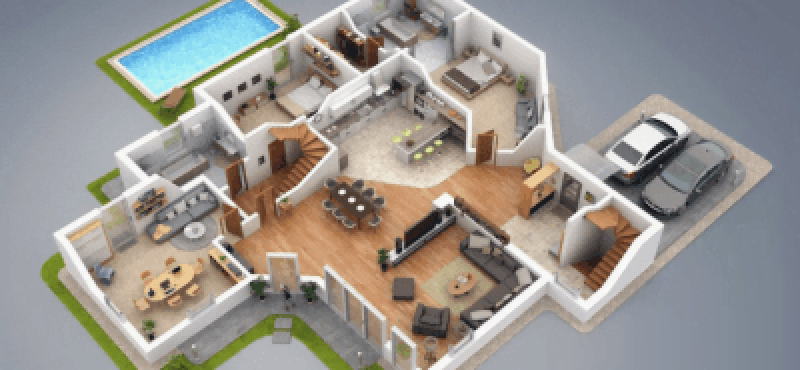INTRODUCTION
When it comes to envisioning your dream home, architectural visualization is key. Finding the right studio to bring these visions to life can be a game-changer. In this comprehensive guide, we’ll explore the top architectural visualization studios, the intricacies of architectural rendering, and how to navigate the world of 3D rendering services to craft the perfect visual narrative for your home.
OVERVIEW
Architectural visualization studios specialize in transforming concepts into tangible, visually stunning representations. From basic blueprints to immersive 3D models, these studios utilize cutting-edge technology to render lifelike environments. Whether you’re designing, renovating, or simply exploring possibilities, these studios offer a pivotal bridge between imagination and reality.
STEP-BY-STEP GUIDE
1. UNDERSTANDING YOUR VISION
Before diving into studio selection, articulate your vision. Define your style, layout preferences, and any specific architectural features you desire. This clarity will guide your search for the perfect studio.
2. RESEARCHING TOP STUDIOS
Explore renowned architectural visualization studios known for their expertise and versatility. Consider factors like portfolio diversity, technology proficiency, and client reviews to shortlist potential candidates.
3. ASSESSING PORTFOLIO & EXPERTISE
Delve into the portfolios of shortlisted studios. Look for projects akin to your vision, assessing the quality, attention to detail, and the ability to create immersive, realistic visuals.
4. COMMUNICATING YOUR VISION
Initiate contact with the studios, discussing your project specifics. Communication is pivotal; ensure they understand your requirements and demonstrate a willingness to collaborate effectively.
5. EVALUATING TECHNOLOGY & TECHNIQUES
Inquire about the technology and techniques employed by the studios. Opt for those utilizing advanced software and methodologies to ensure cutting-edge, high-quality renders.
6. BUDGETING & TIMELINES
Discuss financial aspects and project timelines. A transparent discussion about costs, payment structures, and delivery schedules is crucial for a seamless collaboration.
7. FINAL SELECTION & AGREEMENT
After meticulous evaluation, select the studio that aligns best with your vision, values, and budget. Formalize the agreement, outlining project specifics, timelines, and deliverables.
INFORMATION RESOURCE SECTION
Pro Tips and Secrets:
- Collaborate closely with the studio to ensure your vision is accurately translated into the renders.
- Consider studios that offer post-production support for revisions and adjustments.
GLOSSARY OF TERMS
ARCHITECTURAL VISUALIZATION TERMS
- Aspect Ratio: The proportional relationship between an image’s width and height.
- BIM (Building Information Modeling): A digital representation of a building’s physical and functional characteristics.
- CAD (Computer-Aided Design): The use of computer software to create, modify, analyse, or optimize designs.
- CAD Model: A digital representation of a design or structure created using Computer-Aided Design software.
- Clipping Plane: A boundary within which objects are visible, useful for isolating specific sections of a 3D model.
- Depth of Field: The distance between the nearest and farthest objects in a scene that appear acceptably sharp in an image.
- Flythrough: A dynamic visualization technique involving a continuous movement through an architectural space.
- Global Illumination: A lighting technique that simulates how light bounces and reflects between surfaces, enhancing realism.
- Material Library: A collection of pre-made textures and materials that can be applied to 3D models for realistic surface appearances.
- Perspective View: A rendering viewpoint that shows objects in the image as they appear to the eye, often used to create realistic visualizations.
- Photorealism: The quality of a render being so realistic that it resembles a photograph.
- Physical-Based Rendering (PBR): A rendering approach that simulates real-world material properties to achieve more accurate visuals
- Rendering Engine: Software that generates images from 3D models using lighting, textures, and other parameters.
- Scale Model: A physical or digital representation of a structure, typically in miniature form.
- Storyboard: Visual sequences illustrating key scenes or events, often used to plan animations or presentation.
- UV Mapping: The process of applying a 2D texture to a 3D model’s surface, ensuring the texture fits accurately.
- VR (Virtual Reality): Technology that simulates a realistic environment, allowing users to interact within a computer-generated space.
- Walkthrough: Similar to a flythrough, but typically slower-paced, allowing for detailed exploration of architectural spaces.
CONCLUSION: CRAFTING YOUR VISION
Your home’s architectural visualization is a pivotal step in turning dreams into reality. By understanding the process, selecting the right studio, and fostering effective communication, you pave the way for an immersive visual journey toward your ideal living space.
CALL TO ACTION
Explore our platform for additional insights, share your experiences in the comments, and take the first step toward visualizing your dream home!
FREQUENTLY ASKED QUESTION’S
Consider your preferences, project scope, and the studio’s expertise. Exploring their portfolios can provide clarity.
Look for portfolio diversity, technology proficiency, communication skills, and budget alignment.
Lighting significantly impacts the mood and realism of renders. Studios often use various lighting techniques to enhance visual appeal.
Yes, most studios accommodate revisions within a specified scope. Ensure to discuss revision policies beforehand.
Project durations vary based on complexity. A small project might take a few days, while larger-scale projects could take weeks or months.
JPEG, PNG, TIFF, and PSD are common image formats, while OBJ, FBX, and STL are used for 3D model exports.




